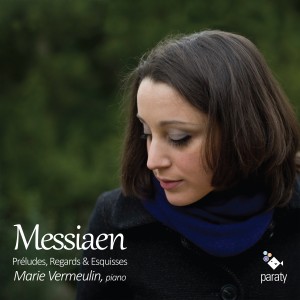
Olivier Messiaen contributed veritable monuments to the piano literature, cycles of tremendous scope such as the Vingt Regards sur l’Enfant-Jésus and the Catalogue d’Oiseaux. These works are bridges between a fruitful past embodied by Claude Debussy and the new language of Messiaen’s own Quatre Études de rythme, which exploit his famous Mode de valeurs et d’intensités. Messiaen’s oeuvre for the piano is remarkable for its technical inventions, its symbolism, and its poetry. These works are also the most condensed statements of a musical language which evolved over time, but to which Messiaen always remained faithful. The distinguishing characteristics include a rich and diverse rhythmic element, a harmonic signature which is identifiable on the first hearing, ubiquitous colors, and ornithological motifs found even beyond the Catalogue d’Oiseaux (Bird Catalogs). In fact, Messiaen’s piano works, which include numerous orchestral scores and chamber music scores in which the piano plays a crucial role, are a wonderful gateway towards the appreciation of such a personal and particular musical universe. And it is not for nothing that so many young pianists dedicate themselves to these works today.
This was not the case when I first asked Olivier Messiaen to lend his name to a piano competition and chair the jury, a proposal which he accepted. The adventure began in Royan, as part of the 1967 Contemporary Art Festival. The competition continued fleetingly at the Rencontres de La Rochelle, only to be interrupted for eight years at the composer’s request while he composed Saint François d’Assise, his only opera. Finally, eight years after his death, the competition joined the City of Paris Competitions at the request of Messiaen’s wife, Yvonne Loriod. Little by little, the competition earned international acclaim which is consistent with a body of work that has known no purgatory…
It was in December 2007 that Marie Vermeulin won a magnificent Second Prize at the Olivier Messiaen Competition, following her brilliant studies at the Conservatoire National Supérieur de Lyon and further studies with Lazar Berman. Her final round included a performance of Oiseaux exotiques with the Ensemble Intercontemporain under Pierre Boulez. However, it was only one step in a journey to explore all of the challenges and wealth of Messiaen’s work, a journey in which she has been encouraged by Roger Muraro, the preeminent proponent of Messiaen’s works. With Muraro she performed the Visions de l’Amen for two pianos at the Messiaen Festival in La Grave, in August 2012. Ms Vermeulin’s first monographic disc, which confirms the young performer’s talent, is also a felicitous summary of Messiaen’s creative trajectory. It includes Eight Préludes from the composer’s youth, two of the most impressive Vingt Regards, followed by the brief Esquisses d’oiseaux, his last piano pieces. We will wait in delightful anticipation for the next stones of Messiaen’s oeuvre that Ms Vermeulin will bring to this edifice.

